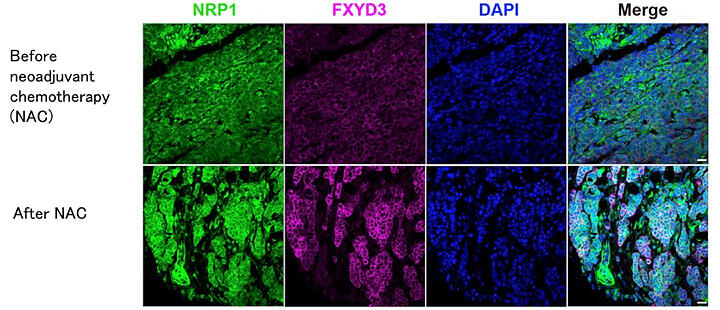A research group including Professor Noriko Goto (Cancer Research Institute, Kanazawa University), Professor Koji Okamoto (Advanced Comprehensive Research Organization, Teikyo University), and Associate Professor Masahiko Tanabe (Graduate School of Medicine, The University of Tokyo), in collaboration with Kyoto University, Tokyo Medical and Dental University, and the Kanagawa Cancer Center, announced their identification of the cells that cause breast cancer recurrence. They successfully identified and extracted the subpopulation of cancer stem cells that are resistant to anticancer drugs. They also confirmed that the extracted cells were killed by treatment with cardiac glycosides. The discovery is expected to lead to the development of treatments for preventing breast cancer recurrence. The study results were published in the November 15 issue of Journal of Clinical Investigation, an international academic journal.

Provided by Kanazawa University
Breast cancer is the most common type of cancer among women worldwide, with the latest statistics showing that 1 in every 9 Japanese women has the disease. It is also the second most common cause of cancer-related death in women. Although advances in diagnostic technology and molecularly targeted drugs have improved the cure rate of breast cancer patients, the disease is still susceptible to metastasis and recurrence.
Breast cancer is divided into several subtypes. Molecular therapy drugs have been developed for the cancer subtypes that are positive for female hormone receptors (estrogen and progesterone receptors) or the cell surface receptor HER2, and good treatment results are expected. However, there are no effective molecularly targeted drugs for the triple-negative breast cancer subtype in which all of these three receptors are negative.
Although preoperative systemic therapy using anticancer drugs or molecularly targeted drugs (neoadjuvant chemotherapy (NAC)) is considered the standard for triple-negative breast cancer, recurrence and metastasis are known to be twice as likely in patients with an NAC resistance prognosis, depending on the disease severity.
The research group hypothesized that the most treatment-resistant cell subpopulation (Drug tolerant persisters (DTPs)) hidden behind the cancer stem cell population after NAC is the cause of post-treatment recurrence and metastasis.
Previously, the research group had reported that cancer stem cells can be concentrated using the cell membrane proteins neuropilin-1 (NRP1) and insulin-like growth factor 1 receptor (IGF1R). Cancer tissue was obtained from patients with treated triple-negative breast cancer, and the stem cells were concentrated using the same method with NRP1 and IGF1R antibodies. The genes expressed in each cell were comprehensively analyzed using single-cell RNA sequencing.
These cancer stem cell populations were then classified into five clusters. In particular, the cancer stem cells in clusters 1 and 2 showed properties very similar to those of mammary gland progenitor cells, which are speculated to generate triple-negative breast cancer. These stem cells were found to be the most resistant to various anticancer drugs.
These stem cells were named "ancestor-like cancer stem cells," and further analysis revealed that they strongly expressed FXYD domain-containing ion transport regulator 3 (FXYD3) on the cell membrane and could be isolated using the same antibody. FXYD3 protects the sodium-potassium (Na+-K+) pump from active oxygen. The Na+-K+ pump, which is located on the cell membrane, pumps Na ions out of the cell and moves K ions into the cell.
When cardiac glycosides (Na+-K+ pump inhibitors used to treat heart failure) were administered to the ancestral cancer cells, the research group found that the cells became less resistant to treatment and could be killed by anticancer drugs. They also confirmed that FXYD3 is strongly expressed in NAC-resistant breast cancer cells.
When breast cancer cells were transplanted into mice and treated with the NAC-mimicking drugs paclitaxel (an anticancer drug) and ouabain (a cardiac glycoside), tumor formation was significantly suppressed over time, indicating that FXYD3-positive ancestral cancer cells had disappeared.
The combination of anticancer drugs with a cardiac glycoside/FXYD3-targeting drug may change NAC resistance into NAC sensitivity. When such strategy is put to practical use, it may suppress cancer recurrence and metastasis and improve the prognosis of patients.
This article has been translated by JST with permission from The Science News Ltd. (https://sci-news.co.jp/). Unauthorized reproduction of the article and photographs is prohibited.




